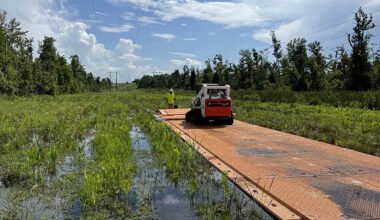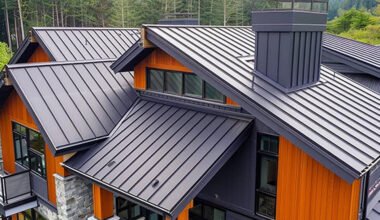The construction industry, known for its vital role in infrastructure development and economic growth, is also an arena where safety is paramount. With numerous hazards present on a construction site, the emphasis on protective measures cannot be overstated. One of the key safety concerns in construction is fall prevention, particularly when work is conducted at height. In this context, edge protection becomes not only a regulatory requirement but also a critical component of site safety protocols.
The Significance of Edge Protection
In the construction sector, the primary objective of edge protection is to safeguard workers from the risks of falling from heights, which can result in serious injuries or fatalities. The utilisation of robust edge protection systems provides a barrier that prevents workers and materials from falling off the edges of floors, platforms, or roofs. It is a collective term that encompasses various protective equipment such as guardrails, safety nets, and toe boards. Edge protection is, therefore, an indispensable element in the hierarchy of construction safety measures.
Compliance with Safety Standards
Regulatory measures impose stringent guidelines that necessitate the installation of edge protection systems on construction sites. These regulations are designed to enforce minimum safety standards that must be adhered to during construction activities. Compliance is not just a legal obligation but also a moral imperative to ensure the well-being of workers. Importantly, adherence to these standards can often mitigate the financial implications associated with workplace accidents and the potential for costly litigation. If someone gets hurt in an accident caused by safety violations, the victim can file a case with the help of a construction accident lawyer.
Types of Edge Protection Systems
Edge protection systems come in various forms, each tailored to specific requirements of the construction industry. Temporary guardrails, for instance, are widely used because they offer flexibility and can be easily installed and dismantled. Permanent edge protection is also available for structures that require long-term safety solutions. Both types are designed to withstand the forces that can be reasonably expected during construction operations.
Integration into the Construction Workflow
The implementation of edge protection is most effective when integrated into the initial planning stages of a construction project. It allows for the systematic incorporation of safety measures without disrupting the workflow. Project managers and safety officers must take into account the various stages of construction, and ensure that edge protection is maintained throughout the entirety of the process. This includes periods of erection, alteration and dismantling of the structures.
Training and Awareness
While the presence of edge protection systems is crucial, their effectiveness is significantly enhanced when coupled with proper training and awareness. Workers must be educated on the correct usage, inspection, and maintenance of edge protection equipment. Regular safety briefings and training sessions can aid in reinforcing the importance of such measures and ensure that all personnel are aware of their responsibilities and best practices concerning site safety.
Technological Advancements in Edge Protection
Technology continues to play a pivotal role in advancing the effectiveness of edge protection systems. Innovations in materials and design have led to lighter, stronger, and more adaptable solutions that cater to the diverse and often complex geometries of modern construction projects. There is an ongoing evolution of edge protection products that offer greater reliability and efficiency, which greatly enhances on-site safety.
Case Studies and Industry Evidence
Case studies from various construction projects around the world provide evidence of the efficacy of comprehensive edge protection systems. These instances showcase reduced accident rates and improved overall safety records for construction firms that implement rigorous edge protection measures. Industry evidence strongly supports the contention that a proactive approach to fall prevention significantly contributes to a safer construction environment.
Cost-effectiveness of Edge Protection
While there are costs associated with the implementation of edge protection, it should be seen as an investment rather than a cost. The avoidance of accidents and the resulting financial benefits from reduced workers’ compensation claims and insurance premiums often outweigh the initial outlay for safety equipment. Moreover, the adoption of integrated edge protection can lead to improved productivity, as workers feel more secure and can concentrate better on their tasks.
Partnership with Reputable Suppliers
Selecting the right edge protection involves partnering with reputable suppliers who understand the stakes involved in construction safety. These suppliers typically offer comprehensive services that include design, installation, and technical support for edge protection systems. Partnering with experts ensures that construction companies can rely on quality equipment that complies with safety standards and aligns with their specific project needs.
The Role of Safety Culture
Ultimately, the success of edge protection in enhancing construction safety is also deeply embedded in the safety culture of an organisation. Encouraging a culture where every worker feels accountable for not just their safety but also that of their colleagues is essential. Management must lead by example, promoting and rewarding safe practices, and ensuring that safety is never compromised for the sake of expedience.
Conclusion
In the high-stakes environment of construction, the importance of edge protection cannot be overstated. Its role in preventing falls from height—a leading cause of construction-related injuries—makes it an invaluable aspect of construction safety. Through proper implementation, regular maintenance, worker training, and a strong safety culture, edge protection serves as a safeguard for workers and a testament to the construction industry’s commitment to health and safety. Partnering with a reliable edge protection provider ensures that safety standards are consistently met, contributing to the overall success and reputation of construction projects.
Construction companies and safety professionals looking for robust safety solutions can explore the offerings of industry experts, such as Australian Scaffolds, which provide a range of edge protection systems designed to meet the challenges of modern construction sites. By prioritising the well-being of their workforce, construction entities foster a safer, more productive work environment where the potential for accidents is markedly reduced.



